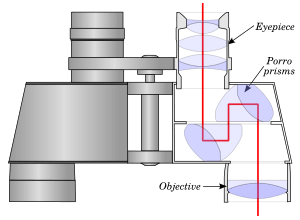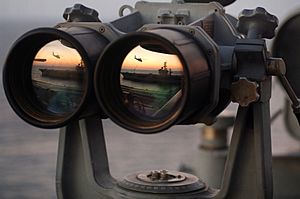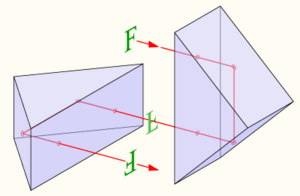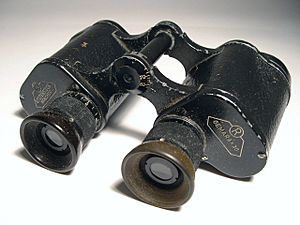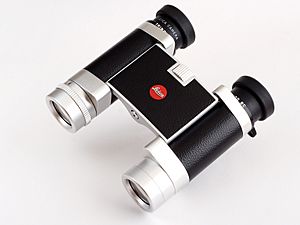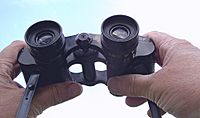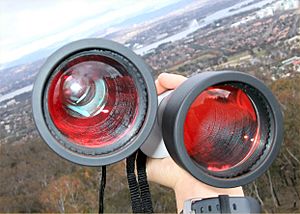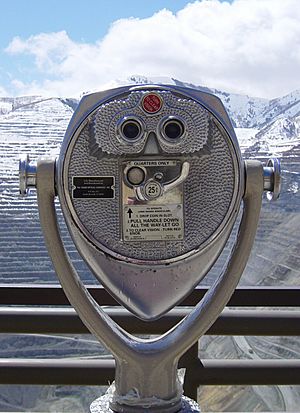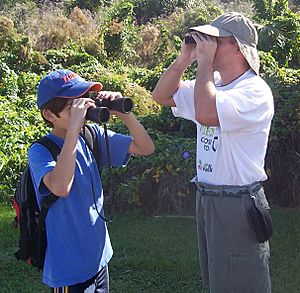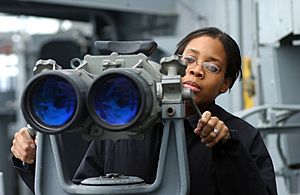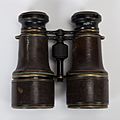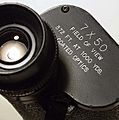Binoculars facts for kids
Binoculars are cool tools that help you see far-away things much more clearly! They use a special technology called optics. Think of them as two small telescopes joined together, one for each of your eyes.
Inside binoculars, there are lenses that gather light and make the image bigger. This process is called magnification. So, when you look through binoculars, a distant object appears much closer. They also have special prisms inside. These prisms bend the light, which helps make the binoculars shorter than a regular telescope with the same power.
Binoculars were first invented in the 1600s. They were a big improvement because they let people use both eyes to look at things. The Royal Navy used to use single telescopes, but now all ships have strong binoculars. Even armies use them! Some special binoculars can even help you see in the dark using Night vision technology.
People use binoculars for lots of fun activities like going to the theatre (opera glasses), watching birds, and looking at the stars as an amateur astronomer.
Contents
Cool Features of Binoculars
Binoculars come with different features to make them work better:
- Focusing: You usually turn a knob to make the image clear. Some big binoculars let you focus each side separately.
- Eye Relief: This is how far your eye needs to be from the eyepiece to see the whole picture. It's super important for people who wear eyeglasses!
- Range Finding: Some binoculars have a special scale inside that helps you guess how far away an object is, if you know its height.
- Image Stabilization: On fancy binoculars, electronics can help stop the image from shaking, making it easier to see clearly, especially at high magnifications.
- Optical Coatings: These are special layers on the lenses and prisms. They reduce glare and help more light get through, making the image brighter and clearer.
Did you know? During World War II, warships used huge binoculars, some as long as 15 meters, to aim their guns at targets far away! Today, we use radar and lasers for that.
How Binoculars Are Designed
There are different ways binoculars are built inside to help you see.
Old-Style Galilean Binoculars
Early binoculars, from the 1600s, often used a simple design called Galilean optics. They had a convex lens at the front and a concave lens at the back. This design gives you an image that's the right way up, but the view is narrow, and it can't magnify things very much. You still see this design in very cheap binoculars or opera glasses.
Binoculars with Keplerian Optics
To get a better image and higher magnification, binoculars started using Keplerian optics. The problem with this design is that it makes the image upside down! So, they needed a way to flip the image right side up.
Binoculars with Extra Lenses
Some older binoculars added extra lenses to flip the image. But this made the binoculars very long. This design was popular in the 1800s but became old-fashioned once prism binoculars came along.
Prism Binoculars
The most common way to flip the image and make binoculars shorter is by adding special prisms inside.
Porro Prism Binoculars
Porro prism binoculars are named after Ignazio Porro, who invented this system. They use a special Z-shaped arrangement of prisms. This makes the binoculars wider, with the front lenses spread out more than the eyepieces. This design also folds the light path, making the binoculars shorter. Plus, the wider spacing of the front lenses can give you a better sense of depth, making objects look more 3D!
Roof-Prisms Binoculars
Roof-prisms binoculars use different types of prisms that are arranged in a straight line. This makes the binoculars much narrower and more compact than Porro prisms. They are often lighter and easier to carry. However, they might not be quite as bright as Porro prisms of the same size, and they need to be made very precisely, which can make them more expensive.
How Binoculars Are Measured
Binoculars have numbers on them that tell you about their power. For example, you might see "7×50".
Magnification
The first number, like the "7" in 7×50, tells you the magnification. This means the object you're looking at will appear 7 times closer than it actually is. For example, if you look at something 70 meters away, it will look like it's only 10 meters away! Most handheld binoculars are between 7x and 10x magnification. If the magnification is too high, the image can shake a lot, and you might need a tripod to keep it steady.
Objective Diameter
The second number, like the "50" in 7×50, is the objective diameter. This is the size of the big front lenses, measured in millimeters. The bigger this number, the more light the binoculars can gather. More light means a brighter and clearer image, especially in dim conditions. So, an 8×40 binocular will give you a brighter and sharper image than an 8×25, even though both magnify the same amount.
Field of View
The field of view tells you how wide an area you can see through the binoculars. It's usually given as how many feet or meters you can see at a distance of 1,000 yards (or 1,000 meters). A wider field of view is great for watching fast-moving things like birds.
Exit Pupil
The exit pupil is the small circle of light you see when you hold the binoculars away from your eyes and look through the eyepieces. Its size depends on the objective diameter divided by the magnification. For example, a 7×50 binocular has an exit pupil of about 7mm (50 divided by 7). If this circle of light is bigger than your eye's pupil, some light is wasted. However, a larger exit pupil makes it easier to position your eyes and see the full image, which is helpful if you're moving or in low light.
Eye Relief
As mentioned before, eye relief is the distance your eye needs to be from the eyepiece. If you wear glasses, you'll want binoculars with longer eye relief so you can still see the whole picture without taking your glasses off.
Close Focus Distance
The close focus distance is the closest an object can be while still being in focus. This can range from half a meter to 30 meters, depending on the binoculars.
Eyepieces
The eyepieces are the parts you look through. They usually have several lenses inside that work together to give you a clear view.
How Binoculars Are Adjusted
Focus and Adjustment
Binoculars have ways to adjust the focus:
- Independent Focus: Each eyepiece is focused separately. This is common on tough binoculars, like military ones, because it helps keep them waterproof.
- Central Focusing: Most binoculars have a central wheel that focuses both sides at once. One eyepiece can also be adjusted separately to match differences between your eyes. Once you set this, you just use the central wheel for different distances.
- Focus-Free: Some binoculars don't have a focusing mechanism other than the eyepiece adjustment. They are set for a general range, which is convenient but not as flexible.
If you wear glasses for nearsightedness or farsightedness, you can often use binoculars without them by just adjusting the focus. But if you have severe astigmatism, you might still need your glasses.
Some binoculars are zoom binoculars, meaning you can change the magnification. While this sounds cool, they can be heavier, more complex, and sometimes give a less bright or clear image, especially at high zoom.
Most binoculars also let you adjust the distance between the two halves to match the distance between your eyes. This is called interpupillary distance.
Image Stability
Some high-tech binoculars have image stabilization. This helps reduce shaky images, especially when you're holding them by hand or using high magnification. They use special sensors and mechanisms to keep the image steady. These binoculars are usually more expensive and heavier, but they make a big difference in how clear the view is.
Alignment
The two telescopes in binoculars must be perfectly lined up, or collimated, to give you one clear, 3D image. If they're not aligned, you might see a double image or feel eye strain. Professionals usually align them at the factory.
Special Coatings on Lenses
Binoculars have many lenses and prisms inside, and each surface can reflect some light away. To make the image better, manufacturers add special coatings.
Anti-Reflective Coatings
These coatings reduce the light that bounces off the lens surfaces. By reducing reflections, more light gets through to your eyes, making the image brighter and clearer. Good coatings can make a huge difference in image quality!
Phase Correction Coatings
These are special coatings used only on roof-prism binoculars. They help keep the light waves in sync after they pass through the prism. This makes the image sharper and improves the contrast. Porro prism binoculars don't need these coatings.
Metallic Mirror Coatings
Some prisms, especially in roof-prism binoculars, need a special mirror coating to reflect light properly. Older binoculars used aluminum or silver coatings. Modern high-quality binoculars use silver coatings and are sealed to prevent tarnishing. Porro prisms usually don't need these because they reflect light perfectly on their own.
Dielectric Mirror Coatings
These are very advanced coatings used on some roof prisms. They are made of many thin layers that reflect almost all the light (over 99%). This makes the image incredibly bright and clear.
Terms for Coatings
When you look at binoculars, you might see these terms:
- Coated Optics: At least one surface has a single anti-reflective coating.
- Fully Coated: All air-to-glass surfaces have a single anti-reflective coating.
- Multi-Coated: Some surfaces have multiple layers of anti-reflective coatings.
- Fully Multi-Coated: All air-to-glass surfaces have multiple layers of anti-reflective coatings. This is the best!
For roof-prism binoculars, you might also see:
- Phase-Coated or P-coating: Has phase-correcting coatings for sharpness.
- Aluminium-Coated or Silver-Coated: Describes the mirror coating on the prisms.
- Dielectric-Coated: Means the prisms have the best, super-reflective coatings.
What Are Binoculars Used For?
General Use
You can find binoculars everywhere! From tiny opera glasses for the theater to larger ones for outdoor adventures. Many tourist spots even have coin-operated binoculars so you can get a super close view of landmarks.
Bird Watching
Birdwatching is a super popular hobby, and binoculars are a must-have tool! Most birdwatchers use binoculars with 7x to 10x magnification to spot birds in trees or flying far away.
Hunting
Hunters use binoculars to spot animals from a distance. They often choose 8x binoculars that are good at gathering light, especially in dim conditions like dawn or dusk.
Military Use

Binoculars have been used by the military for a long time. Military binoculars are usually extra tough and waterproof. Some modern military binoculars even have filters to block dangerous laser beams and can include a special scale to help soldiers estimate distances.
Looking at the Stars (Astronomy)
Many amateur astronomers love using binoculars! Their wide field of view is great for finding comets, supernovas, and large groups of stars like the Milky Way. Binoculars with larger front lenses (like 70mm or 80mm) are best for astronomy because they gather more light, letting you see fainter stars.
You can see many amazing things in the night sky with binoculars:
- The Moon's craters.
- The dim outer planets like Uranus and Neptune.
- Jupiter's four largest moons, called the Galilean moons.
- Saturn's largest moon, Titan.
- Beautiful star clusters like the Double Cluster in Perseus.
- Some nebulae like the Omega Nebula and the North American nebula.
- Even the Andromeda galaxy (Messier 31) can be seen as a fuzzy patch!

For very faint objects or super high magnification, astronomers might use special binoculars that are so big they need a tripod or mount to hold them steady.
Images for kids
-
Parameters listed on the prism cover plate describing 7 power magnification binoculars with a 50 mm objective diameter and a 372 foot (113 m) field of view at 1,000 yards (914 m)
-
German U.D.F. 7×50 blc U-boat binoculars (1939–1945)
-
7×50 marine binoculars with dampened compass
See also
 In Spanish: Prismáticos para niños
In Spanish: Prismáticos para niños


